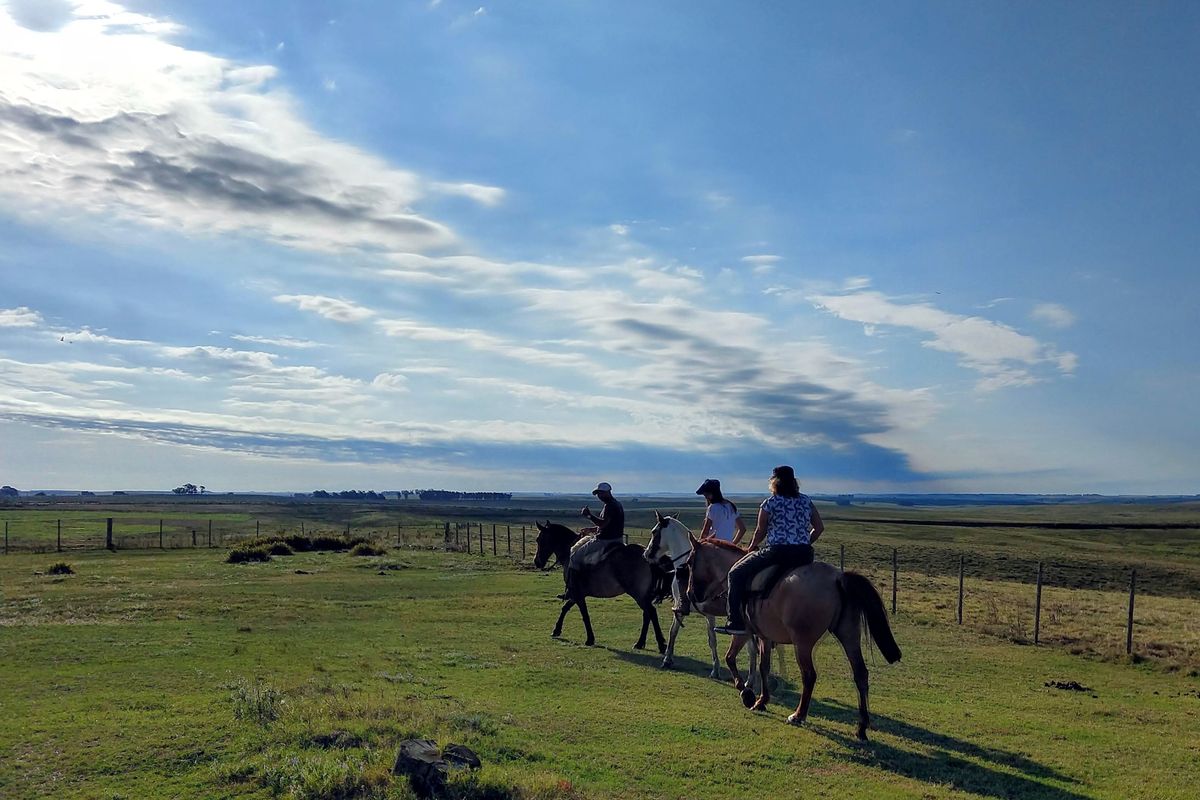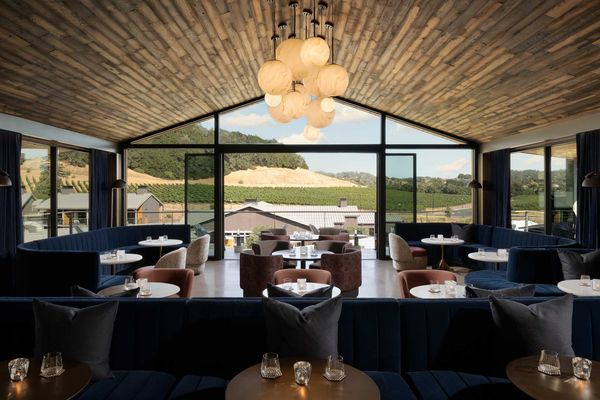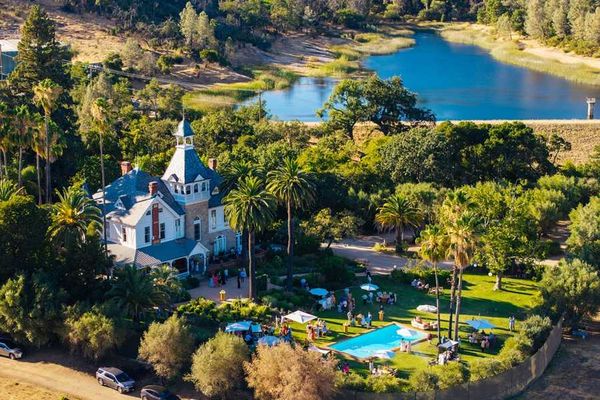Catch the sunset over a horizon of grass on the Uruguayan pampas, ride horses alongside gauchos working their herds, bed down in a rustic master bedroom, and feast on hearty meals and stories from a family that has lived off their land since the 1850s.
This is not your father's dude ranch: It's a gaucho getaway deep in South America.
Travelers familiar with Uruguay know it as a quick ferry ride away from Buenos Aires: a place to revel at the seaside stretches of Punta del Este or relax in the more tranquilo vibe of José Ignacio. But another sea awaits you in Uruguay's vast interior: rolling waves of grassland and forest where locals welcome guests to stay at their ancestral ranches, known as estancias.
Though Uruguayan estancia owners have been hosting paying guests for only about 25 years, the service is a natural extension of a longtime tradition. As Marina Cantera of Estancia Los Plátanos puts it, "Family and friends visit on the weekends for asados and holidays anyway, so we already had much of what we needed for other guests." And while Argentinian estancias have been in the dude ranching business a few decades longer, in Uruguay, the feeling is closer to a home stay, "When you come here, you become part of our family," she says.
With only three guest rooms available at Estancia Los Plátanos, it's a pretty small family, so we got plenty of personal attention when we visited. Breakfast was waiting for us each morning at our chosen hour of 8am. As we rambled into the dining room, we were greeted by a spread of hot, homemade scones served with butter, jam, and cream cheese; soft scrambled eggs straight from the frying pan; chewy, bite-sized balls of Brazilian-style pan de queso made with manioc flour; blueberry muffins stacked neatly in a glass dome next to a bowl of fresh apples, pears, peaches, and oranges; a carafe of strong coffee with warmed milk on the side; and a fresh pitcher of orange juice.
Following breakfast in the dining room—the only WiFi-equipped spot in the small compound—we relaxed in the shade of a century-old ombú tree that reached a height of about 35 feet and sported a leafy canopy of a similar diameter. It didn't take long for Tuco, the sheep that thinks he's a dog, to wander over and butt his wooly head into our legs. He accepted a few scratches before collapsing beneath the wooden table, one front leg stretched out like a pup's, the other tucked beneath like a sheep's.
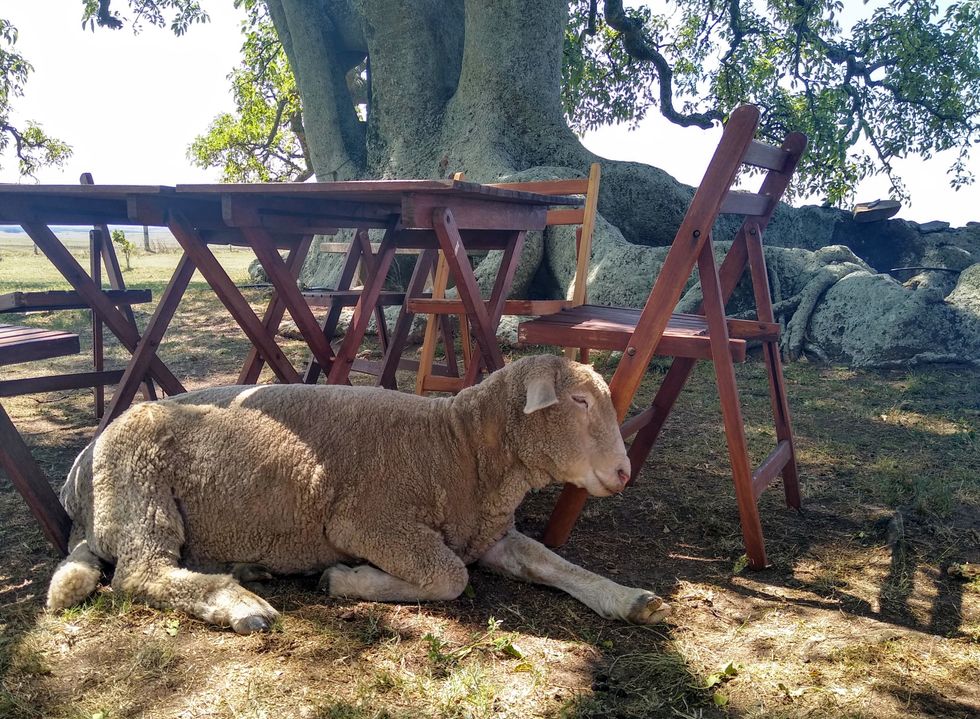
After lounging long enough to let breakfast settle, we wandered into the kitchen for walking directions to the swimming hole. Following Marina's instructions, we strolled across a vast field of low green grass punctuated with thigh-high thistle stalks and plentiful piles of cow manure. We paused periodically to take snapshots of pint-sized armadillos called mulitas, which scurry through the brush during the daytime, foraging for food. A cluster of gnarled, stunted trees surrounded by lichen-covered boulders signaled the entrance to the section of the creek that had been dammed by hand to form a chest-deep pool. We followed an open path through the copse to find the fence Marina had told us to climb through.
As a reward for our minimal efforts, we found a waterfall cascading down a rock wall into a sparkling pool of bracingly cold water. The day was humid, but not quite hot enough to counteract the chilliness of full immersion. So we settled for dipping our feet into the surface before returning to the ranch house, stomachs grumbling.
The kitchen island was piled high with homemade gnocchi for lunch. Marina's 20-year-old daughter, Mikaela, set the table while her mother used a cleaver to herd the potato pasta into a beveled platter before directing it into a giant vat of boiling water. Within minutes, the whole family was gathered around the wooden dining table, discussing potential afternoon activities and already pondering dinner over steaming bowls of toothsome pastry puffs draped a rich tomato sauce studded with tender bits of lamb.
In preparation for an afternoon horseback ride across the pampas, we decided to take a siesta. The estancia's 20-foot ceilings and double-walled structure (insulated with decades-old horse manure) kept our 80-square-foot room cool and comfortable during the heat of the summer-in-January day. We were lulled to sleep by an orchestra of frogs who provided a 24-hour soundtrack of mild complaints that quickly grew on us. Two blissful hours later, we rolled out of the four-poster, king-sized bed, ready to get our gaucho on.
Mikaela and her father, Andres, had the horses rounded up and ready to saddle when we met them by the tack room, a stone-walled building housing all the equine riding equipment. Andres described the tools of the trade in Spanish while Mikaela translated. The lesson included the multi-layered saddling process, which starts with a wool blanket held in place by a leather belt that is looped snugly but not cinched. Next comes the saddle, a simple structure laced together with leather along the spine and sporting basic metal stirrups, but no saddle horn or straps. A thick, woolly sheep hide is placed on top of the saddle and held in place by a second, thinner belt.
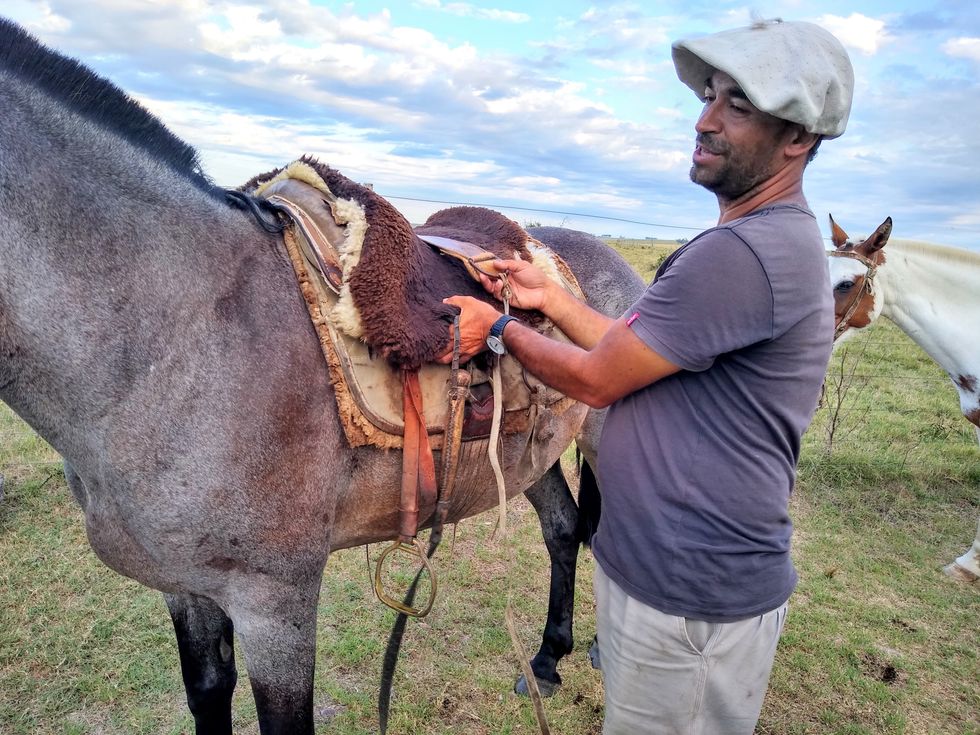
The short riding lesson included how to stay in the hornless saddle by pressing your feet forward into the stirrups and out to the side—like highway pegs on a cruiser motorcycle. Gaucho horses are neck-reined, so "steering" them is also motorcycle-like, though only the left hand is used. To turn right, lay the reins over the left side of the horse's neck and lean, slightly, into the curve.
Once we'd all mounted up, we rode single file through the fence and headed across the rolling green hills to check on the cattle, a mix of white-faced, doe-eyed Herefords, shiny Black Angus, and a red-hued combination of the two. Depending on cattle prices and the abundance of grass, the family buys 200 to 300 head of cattle each spring to fatten up over the summer, selling them in the fall when their weight has doubled. They also raise sheep, maintaining a small herd that provides the primary meat source for the estancia.
Marina and Andres both proclaim a preference for the Black Angus breed, pronouncing them well-suited for life on the pampas and more community-minded than the Herefords. "If a Hereford cow dies, the other mothers will ignore her orphaned calf," Marina explains. "But if we introduce that calf to the Black Angus herd, the mothers will welcome it into the community and nurse it alongside their own calves." In fact, she says, the Angus herd seems to operate its own nursery co-op, with mothers taking shifts to feed all the calves while their off-work peers graze contentedly.
Mikaela pointed out bird species as we rode: the giant ravens that prey on newborn lambs, and the wrinkly red-headed turkey vultures whose circling patterns alert them to dead or injured livestock and clean the carrion from the pampas. "Those are ñandu," she said, gesturing toward a trio of long-legged land birds loping across the horizon.
When a curious pair of wild horses came a bit too close for comfort, Andres whipped out his fusto, a riding crop with a wrist strap on one end and a strip of leather attached to the other, and swung it in a fast circle overhead while galloping toward the duo. When they changed direction abruptly, Mikaela breathed a sigh of relief. "We never know exactly how our horses will react to the wild ones, and we don't want to take any chances with our guests."
After two hours of riding, we returned to the compound, cleaned up for dinner, and tucked into a thick onion pie accompanied by a simple green salad dressed with a tangy salsa criolla. After dinner, we brought a bottle of Tannat, the country's ubiquitous deep red wine, to the front lawn to watch the technicolor sunset with Tuco. Clinking our glasses together, we toasted the remote, natural beauty of the Uruguayan interior.
When the time came to leave a few days later, we were thoroughly relaxed, pleasantly stuffed with homegrown lamb, and not at all ready to return to reality. Our hosts seemed reluctant for us to leave as well. After many rounds of hugs and promises to keep in touch via email, Andres and Mikaela drove us down the mile-long dirt road to the paved, two-lane highway where we waited together in the shade of the pick-up truck until the daily bus crested the hill. Andres helped load our bags into the belly of the bus, and we waved good-bye to our temporary home on the range.
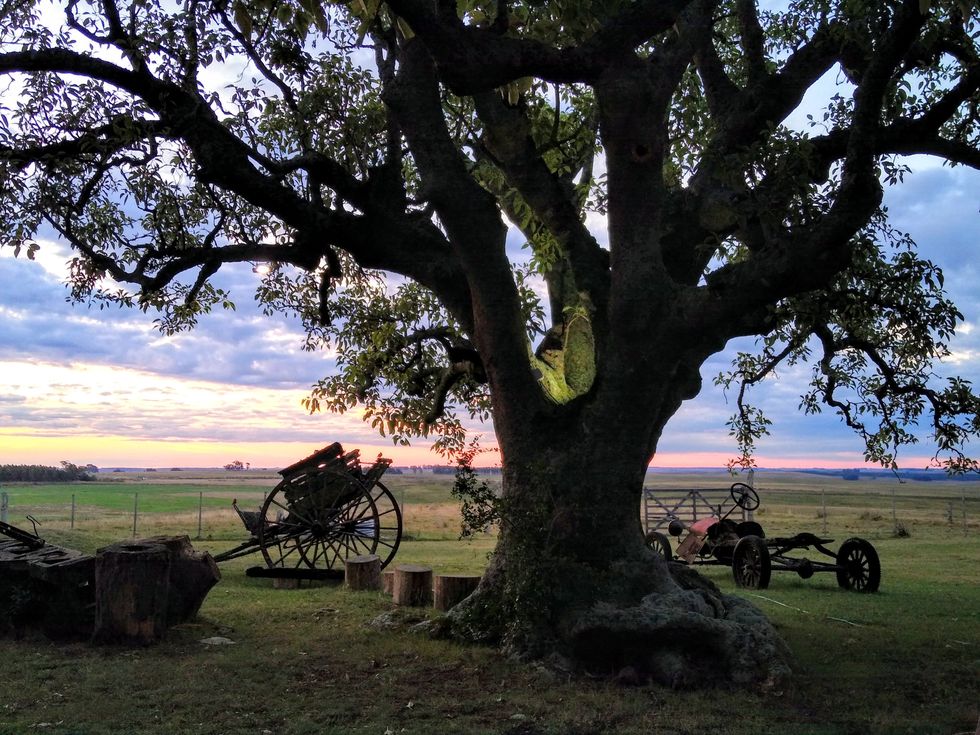
Getting There
Estancia los Plátanos is accessible from Montevideo by bus (4.5 hours), taxi (a bit shorter), or personal pick-up by ranch owner Andres Noblia, who knows the highway and country roads like the back of his hand (2.5 hours). To reach Montevideo, you can take a two-stop flight from SFO to MVD starting around $1,000 round trip. Another option is a one or two-stop flight into Buenos Aires (AEP or EZE) for a similar price, followed by a ferry to Montevideo. We are partial to Avianca Airlines, which seems to have a better on-time record for this route than other options.
Stays at Estancia los Plátanos start at $55 per person per day, including meals. Horseback riding is available for $25 per person, and cooking classes are offered for $20 per person.
More Estancias in Uruguay
Uruguay's estancias range from kid-friendly country hotels to self-contained rustic ranches where you can help herd livestock. Given the remote locations for most estancias, it is advisable to opt for full meal service when making your reservation.
San Pedro de Timote With 31 guest rooms, air conditioning, three swimming pools (one indoor), a professional chef, and the capacity to host your wedding, San Pedro is among the more luxurious choices. // Email for rates; sanpedrodetimote.com
El Ceibo Only an hour's drive from the Montevideo airport, this traditional working ranch is the easiest to access. The estancia offers bicycles, horseback riding, fishing, canoeing, and hiking. // Starting at $390/day for double occupancy, including meals and horseback riding, estancia-hosteria-el-ceibo-uy
Yvytu Itaty One of the most remote of the working estancias, Yvytu Itaty is a favorite among adventure travelers. Guests can help with chores around the ranch, and experienced riders are welcome to saddle up and take off alone. Water comes from a spring, wood stoves provide the heat, and electricity and internet are only available for a couple of hours each day, when the generator is fired up. // Starting at $60 per person/day for double occupancy, including meals and horseback riding, viviturismorural.com.uy
La Estiria In addition to having 12 guest rooms, La Estiria offers guests who don't want to stay overnight a day package that includes two meals, tea and coffee, access to the swimming pool, and horseback riding. // Starting at $150 per person/day for double occupancy, including meals and horseback riding, laestiria.com
For more info about estancias in particular and Uruguay in general, check out The Guru'Guay Guide to Uruguay: Beaches, Ranches and Wine Country. Author Karen Higgs also answers all your burning questions about this small but mighty South American country at guruguay.com.



